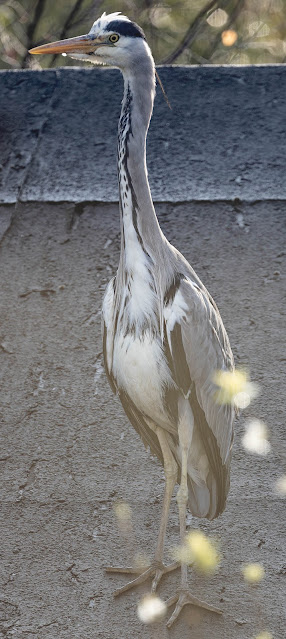Heronry or rookery?
Young heron on outbuilding roof
Apparently, a heronry is a breeding site consisting solely of herons. If other birds are also breeding there it is a rookery. I always thought a rookery referred solely to a breeding colony of rooks, but I have just discovered that the name can also be used for breeding colonies of seabirds, wading birds, seals and turtles.
I was going to say that we have a heronry near us, but actually, it’s a rookery. (I still prefer 'heronry') In any case, we often see herons flying overhead. Occasionally, a heron visits our garden, or, more specifically, our pond.
More mature heron - the markings are more defined - I think!
Herons (Ardea cinerea) are large wading birds that mainly feed on fish but will also take frogs, small birds and mammals. They have long necks and legs and an impressively large wingspan of about 6’. They also have long toes, which are useful when they are wading in mud. When flying or roosting, they tuck in their necks. Sitting on a tree branch with its head tucked in, a heron resembles a little old person, looking grumpy and out of sorts.
Nonetheless, it is exciting to see an enormous bird, almost one metre tall, swooping down and landing in the garden. The one we have seen recently looks younger and smaller than others in the past.
Herons are sociable birds and nest in long-established heronries. Heronries can be extremely large - in 1866 one heronry in Sussex contained 400 nests. The largest one in recent years has been in Kent and had 150 nests. Commonly one tree can support 10 nests.
Beware of getting too close to a nesting heron, for when disturbed, it is normal for it to regurgitate its last meal. A shower of half-digested fish is not destined to enhance anyone’s day!
Heron on nest - steer clear!
Increasingly, little egrets (Egretta garzetta) can be found nesting alongside herons. Little egrets are small white herons that started breeding in UK in Dorset in 1996, about seven years after they first started appearing on these shores. Their diet consists mainly of fish, though they will also eat frogs, worms and occasionally small rodents.
Little egret in flight













.jpg)






.jpg)






























